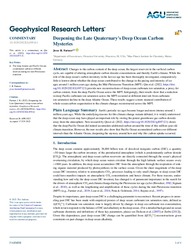Deepening the Late Quaternary's Deep Ocean Carbon Mysteries
DOI: https://doi.org/10.1029/2022GL099161
Persistent URL: http://resolver.sub.uni-goettingen.de/purl?gldocs-11858/10232
Persistent URL: http://resolver.sub.uni-goettingen.de/purl?gldocs-11858/10232
Supplement: https://doi.org/10.1029/2021GL097121
Farmer, Jesse R., 2022: Deepening the Late Quaternary's Deep Ocean Carbon Mysteries. In: Geophysical Research Letters, Band 49, 13, DOI: 10.1029/2022GL099161.
 |
Dokument öffnen: |
Changes to the carbon content of the deep ocean, the largest reservoir in the surficial carbon cycle, are capable of altering atmospheric carbon dioxide concentrations and thereby Earth's climate. While the role of the deep ocean's carbon inventory in the last ice age has been thoroughly investigated, comparatively little is known about whether the deep ocean contributed to the change in the pacing and intensity of ice ages around 1 million years ago during the Mid‐Pleistocene Transition (MPT). Qin et al. (2022, https://doi.org/10.1029/2021GL097121) provide new reconstructions of deep ocean carbonate ion saturation, a proxy for carbon content, from the deep Pacific Ocean across the MPT. Intriguingly, their results show that a reduction in deep Pacific carbonate ion saturation across the MPT occurred at different intervals from carbonate ion saturation decline in the deep Atlantic Ocean. These results suggest a more nuanced contribution of whole‐ocean carbon sequestration to the climate changes reconstructed across the MPT. Plain Language Summary:
Earth's periodic ice ages became longer and more intense around 1 million years ago. While the underlying reasons for this climate change remain debated, it is widely understood that the deep ocean may have played an important role by storing the potent greenhouse gas carbon dioxide away from the atmosphere. New research by Qin et al. (2022, https://doi.org/10.1029/2021gl097121) shows that the deep Pacific Ocean did indeed accumulate additional carbon around the time of this million‐year old climate transition. However, the new results also show that Pacific Ocean accumulated carbon over different intervals than the Atlantic Ocean, deepening the mystery around how and why this carbon uptake occurred. Key Points:
The deep Atlantic and Pacific Oceans accumulated carbon at different intervals during the mid‐Pleistocene transition.
Statistik:
ZugriffsstatistikSammlung:
Schlagworte:
DICmid‐Pleistocene transition
carbonate ion
planktic foraminifera shell weight
benthic foraminifera B/Ca
This is an open access article under the terms of the Creative Commons Attribution‐NonCommercial License, which permits use, distribution and reproduction in any medium, provided the original work is properly cited and is not used for commercial purposes.

